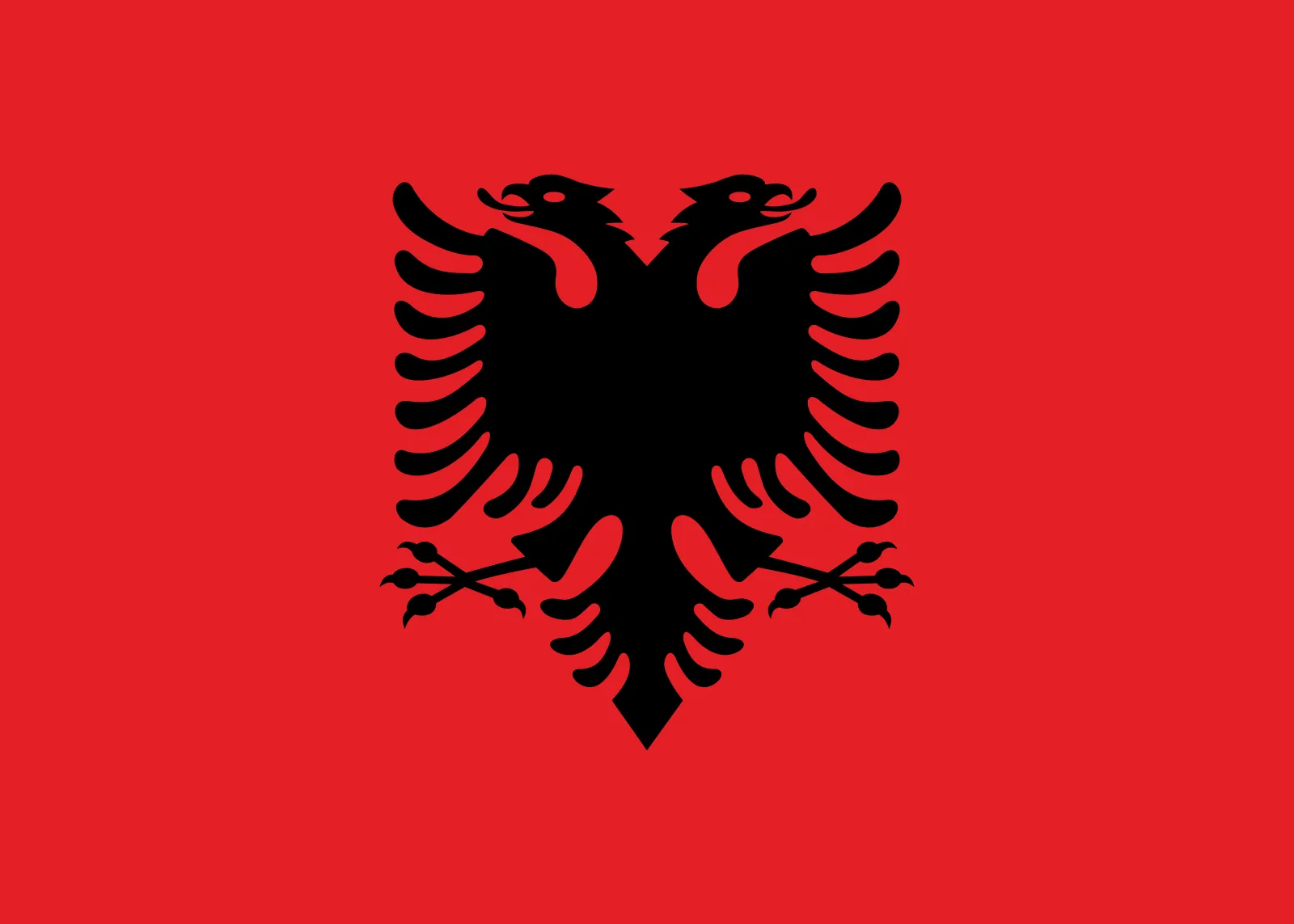Albania
-

Albania, situated in Southeastern Europe on the Balkan Peninsula, is a country brimming with natural beauty, rich history, and cultural diversity.
Geography: Albania boasts a stunning coastline along the Adriatic and Ionian Seas, with rugged mountains, fertile plains, and picturesque lakes dotting its landscape. Its neighbors include Montenegro to the northwest, Kosovo to the northeast, North Macedonia to the east, and Greece to the south.
Capital and Major Cities: Tirana serves as the capital and largest city of Albania, renowned for its colorful buildings, bustling streets, and vibrant atmosphere. Other significant urban centers include Durrës, Vlorë, and Shkodër.
Population: Albania is home to approximately 2.8 million people, composed of various ethnic groups, with Albanians comprising the majority. Minority communities such as Greeks, Macedonians, and others contribute to the country’s cultural mosaic.
Language: The official language of Albania is Albanian, a unique Indo-European language with its own distinct dialects and regional variations. It is spoken by the vast majority of the population.
Independence: Albania declared its independence from the Ottoman Empire in 1912, becoming a sovereign nation after centuries of Ottoman rule. However, its path to stability and nation-building was fraught with challenges, including periods of foreign occupation and internal strife.
Religion: Religion plays a significant role in Albanian society, with Islam, Christianity (both Orthodox and Catholic), and smaller religious communities coexisting peacefully. Albania is known for its religious tolerance and secular government.
Culture: Albanian culture is characterized by its unique blend of influences from East and West, reflected in its cuisine, music, dance, and traditions. Folklore and traditional arts are celebrated, showcasing the country’s cultural diversity.
Economy: Albania has undergone significant economic reforms since the end of communist rule in the early 1990s. It has transitioned to a market-based economy, with sectors such as tourism, agriculture, and energy contributing to its growth and development.
European Integration: Albania aspires to join the European Union (EU) and has made progress towards fulfilling the criteria for membership. However, challenges such as corruption, organized crime, and political instability remain obstacles on its path to EU accession. Despite these challenges, Albania continues to strive towards a brighter future, embracing its identity as a proud and resilient nation.
History
The history of Albania is a rich tapestry woven with threads of ancient civilizations, medieval kingdoms, Ottoman rule, and modern nation-building efforts. Here is a comprehensive overview of Albania’s historical journey:
Ancient Albania:
The territory of present-day Albania has been inhabited since ancient times, with evidence of human presence dating back to the Paleolithic era.
During antiquity, the region was inhabited by various Illyrian tribes, known for their decentralized governance and warrior culture. Illyrian settlements dotted the landscape, with notable cities such as Shkodra (Scodra) and Apollonia.
The Illyrians interacted with neighboring civilizations, including the Greeks and Romans, and were known for their resistance against foreign invasions.Medieval Period:
In the Middle Ages, Albania was part of the Byzantine Empire, which exerted influence over the region through its administrative and ecclesiastical structures.
The 11th century witnessed the emergence of the Principality of Arbanon, considered one of the earliest Albanian states. Its ruler, Progon, is regarded as the founder of the Albanian medieval statehood.
Throughout the medieval period, Albania was a battleground for competing powers, including Byzantium, the Bulgarian Empire, and the Serbian Kingdom.Ottoman Rule:
In the late 14th century, Albania fell under Ottoman rule after the Battle of Savra in 1385. The Ottoman Empire established administrative control over the region, ushering in a period of Islamization and cultural assimilation.
Despite Ottoman domination, Albanian resistance persisted, led by figures such as Skanderbeg (Gjergj Kastrioti), who successfully defied Ottoman authority for decades in the 15th century.Modern Era:
Albania remained under Ottoman rule until the late 19th century when it declared independence on November 28, 1912, following the First Balkan War.
The newly independent Albania faced internal strife and external threats, including territorial disputes with neighboring states.
In 1928, Albania became a kingdom under King Zog I, but his reign was marked by authoritarian rule and instability.
During World War II, Albania was occupied by Italy and later by Nazi Germany. Communist forces led by Enver Hoxha emerged victorious after the war, establishing a totalitarian regime that lasted until the early 1990s.
The fall of communism in 1991 ushered in a new era of democracy and economic transition for Albania, albeit accompanied by challenges such as political instability, corruption, and organized crime.
Since the 21st century, Albania has pursued European integration, aiming to join institutions such as the European Union and NATO while grappling with issues of governance, economic development, and social transformation.Historical Figure
One prominent historical figure of Albania is Gjergj Kastrioti, widely known as Skanderbeg. Skanderbeg was a nobleman and military leader who played a crucial role in Albania’s resistance against the Ottoman Empire in the 15th century.
Born in 1405 in the fortress of Krujë, Skanderbeg was raised in the Ottoman court as a hostage, a common practice to ensure the loyalty of noble families. However, he later defected from the Ottoman army and returned to Albania, where he rallied his people to resist Ottoman rule.
Skanderbeg’s military prowess and strategic brilliance enabled him to successfully lead a series of revolts against the Ottomans, despite facing overwhelming odds. He united various Albanian clans and principalities under his leadership, forming the League of Lezhë in 1444, a coalition dedicated to defending Albania’s independence.
Skanderbeg’s most famous victories include the Siege of Krujë, where he withstood numerous Ottoman sieges, and the Battle of Torvioll, where he decisively defeated Ottoman forces. His guerilla tactics and knowledge of the terrain enabled him to outmaneuver larger Ottoman armies for over two decades.
Skanderbeg’s resistance inspired hope and admiration not only among Albanians but also among European powers, who saw him as a symbol of Christian defiance against the Ottoman threat. He received support from various European leaders, including Pope Pius II and King Alfonso V of Naples.
Despite his military successes, Skanderbeg faced constant pressure from the Ottomans and their allies. He died in 1468, leaving behind a legacy of heroism and national pride. His efforts delayed Ottoman expansion into Europe and preserved Albania’s independence for a time, earning him the title “Athleta Christi” (Champion of Christ) from Pope Calixtus III.
Skanderbeg remains a revered figure in Albanian history and culture, celebrated for his leadership, courage, and unwavering commitment to his homeland’s freedom. His legacy continues to inspire Albanians as a symbol of resilience and defiance against oppression. Monuments, statues, and cultural references throughout Albania pay homage to his memory, ensuring that his name is eternally synonymous with Albanian national identity.
-
1st1 Best thing I’ve read today.

